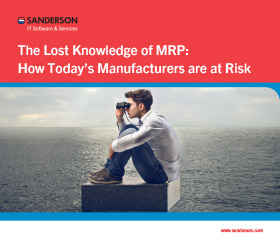The Lost Knowledge of MRP: How Today’s Manufacturers Are at Risk
As the baby boomers retire, a generation of MRP knowledge is leaving with them – but avoiding MRP blunders means knowing and applying the core principles, as well as using the right discrete manufacturing systems.
The original generation of MRP ‘gurus’ are retiring from the workplace, taking their knowledge of discrete manufacturing systems with them. Their shoes are being filled by a generation who know how MRP software operates, but how well do they understand what MRP is trying to achieve?
What caused the impending knowledge crisis?
- The generation retiring today entered the workforce in the 70s and 80s.
- The first MRP systems were also developed in the 70s and 80s.
- The result is a highly-skilled workforce that understands MRP but is now swapping their desks for the golf course.
“Whenever an individual or a business decides that success has been attained, progress stops.”
MRP is more than just software
Today when people talk about MRP, they’re often referring to the complex computer systems that support manufacturing operations. But there’s much more to MRP than that . . .
An effective MRP manufacturing system encompasses the entire production process and focuses on four key objectives:
- Maximise production efficiency.
- Minimise inventory costs.
- Provide flexibility for change.
- Minimise customer delivery times.
“Many leaders of big organisations, I think, don't believe that change is possible. But if you look at history, things do change, and if your business is static, you're likely to have issues.” Larry Page, co-founder of Google
Computers just do what they are told.
There are several dangers for your business of not looking beyond software to fully understand MRP . . .
- If your staff aren’t trained to understand the principles of manufacturing systems, just the software, their perspective is restricted to what the system can do.
- If software is installed without being aligned with your business strategy, MRP can limit or even conflict with your plans.
- Manual processes quickly develop to solve problems, introducing more scope for error.
“To err is human, but to really foul things up you need a computer.”
Rediscover the MRP secret
Be honest – is your business’s MRP expertise represented in your processes or just in your eldest staff?
If you want to protect your business, action is required to ensure that:
- Your processes and business knowledge are documented and controlled.
- You train staff in MRP best practices.
- You have business software configured to support MRP best practices.
It is hard work to do alone – so ensure you have a partnership with an MRP software supplier who understands the fundamentals of MRP, is committed to serving businesses like yours and has a track record of success.
Simply, choosing how to run and support your business involves looking beyond the bells and whistles of a software package.
Discover how one of the oldest manufacturers in London is embracing new techniques, such as an online store, to remain competitive.
Checklist to identify the right software supplier to support MRP:
- They have a strong grasp on the MRP issues affecting your specific industry.
- Their solutions go beyond software, encompassing all your manufacturing processes.
- They understand that for simpler businesses, MRP isn’t always appropriate.
To read success stories of small to medium-sized businesses who recognised problems with their systems and reaped the rewards of implementing change, download our free eGuide: 50 Shades of ERP – Pain Relief Stories
Topics: Discrete Manufacturing Systems




